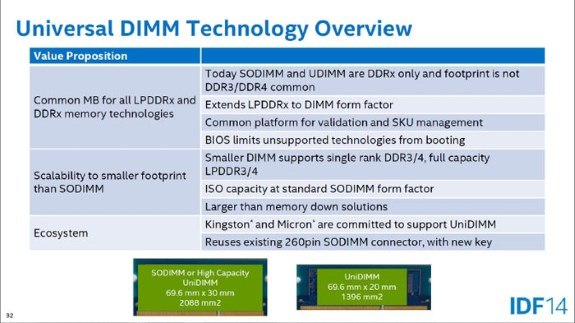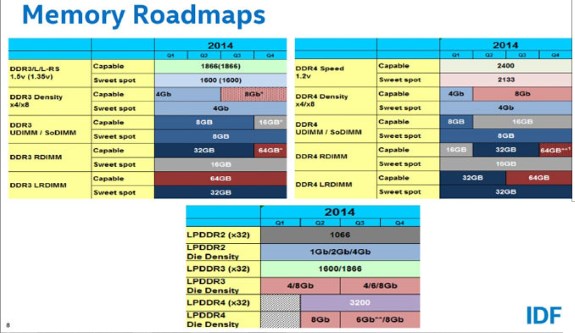
Intel wants to make sure that memory makers can sell their rising inventories of DDR3 memory before DDR4 hits the market and the company has come up with a new memory module form factor called UniDIMM. This DIMM can hold either DDR3 or DDR4 memory chips and Skylake will have an integrated memory controller that supports both DDR3 and DDR4, giving customers and OEMs the choice of adopting the new DDR4 memory or sticking with the older DDR3 memory which will remain a bit cheaper at first.
In the past we've seen motherboards with support for two memory standards but UniDIMM is different, this form factor will make it possible to use DDR3 and DDR4 generation memory chips in the same slot.
The effort is primarily targeted at laptops. DDR3/LPDDR3 UniDIMMs will have a default frequency of 1866MHz whereas DDR4/LPDDR4 will start at 2666MHz.
Intel's bright idea about transitioning between DDR3 and DDR4 for mainstream client platforms is not hugely different from how its P35 Express chipset dealt with the issue. It plans to come up with a new memory module form-factor, called UniDIMM. It's a DIMM that can hold both DDR3-class and DDR4-class DRAM chips, designed for Intel's upcoming Core "Skylake" processors. "Skylake" will feature an IMC that supports both DDR3 and DDR4. With UniDIMM at their disposal, system manufacturers can source UniDIMM modules with DDR3 DRAM chips (which will be cheap, until DDR3 inventories begin drying up), and offer upgrade potential to UniDIMMs with DDR4 chips (which will get progressively cheaper). Future notebooks that ship with DDR4-UniDIMM memory will still support older DDR3-UniDIMM.
/
Capiche? No? UniDIMM is a standardized module design, with its key cutout notch at a certain point. Measuring 69.6 mm x 20 mm, it's as wide, but shorter than an SO-DIMM. There will be two kinds of UniDIMMs, DDR3 UniDIMM and DDR4 UniDIMM, both having 260 pins, the same key position (but one that's different from DDR3 SO-DIMM), and hence work on a platform that supports both standards, "Skylake," in this case. The module will be designed to support both standard- and LP- DDR3 and DDR4 DRAM chips.


Source: TPU